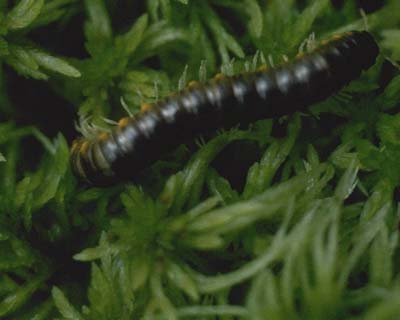 Take a stroll in Olympic's
forests and you will undoubtedly find one of these creatures foraging atop
the forest floor. Some call it "night-train" because of the yellow spots
along the side of its body that float along like brightly-lit windows on
a train.
Take a stroll in Olympic's
forests and you will undoubtedly find one of these creatures foraging atop
the forest floor. Some call it "night-train" because of the yellow spots
along the side of its body that float along like brightly-lit windows on
a train.
What is a millipede?
Millipedes are very
ancient creatures, among the first land animals to crawl on land. They
are Myriapods, having a short head, long segmented body and many paired
legs. Belonging to the class Diplopoda, millipedes can be recognized by
having two pairs of legs on each body segment. True insects have only 3
segments--a head, thorax, and abdomen--but millipedes can have up to 20.
Habitat and Lifecycle
The almond-scented
millipede lives in Olympic's moist forests and their range extends from
California to Alaska. A millipede moves though the leafy layer holding
its slightly-curled antennae in front of it to feel and smell the way.
Its many legs are needed step
over and around
the leafy particles and its body is flattened so it can fit into cracks
and crevices on the forest floor. As a decomposer it chews up needles and
other dead plant material and recycles it into soil.
Reproduction
In the spring mating
occurs and several hundred tiny eggs are laid in soil or duff. When the
young hatch, they are paler in color than mature adults. Each time they
molt, they add a segment and become a darker shade of gray and have brighter
yellow spots. Once are they are about 4 to 5 cm long, with their black
and yellow colors, they are mature and are able to reproduce. By now, they
have about 20 segments and females have 31 pairs of legs, while males have
only 30. The missing pair of legs on the male is modified into a gonopod
for sperm transfer. Yellow-spotted millipedes live to about 2 to 3 years
of age.
Survival Strategies
1. Almond-scented
millipedes use their scent as a defense mechanism. When predators such
as a beetles or shrews near, they release their cyanide scent which is
toxic to their predators in very small dosages. Despite the poison, some
beetles manage to eat almond-scented millipedes.
2. They also
protect themselves from being eaten by curling up into a tight ball, resembling
a snail with a hard exo-skeleton.
3. The bright
yellow spots on a black background serve to warn potential predators of
their poisons.
|
